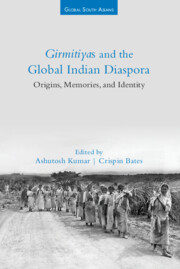2 - Life on The Plantations: Indentured Indians in South Africa and Fiji, 1860–1917
Published online by Cambridge University Press: 20 April 2024
Summary
This chapter aims to reconstruct life for Indian labourers under the indenture system on the sugar plantations of South Africa and Fiji, examining their everyday experiences, ritual observances and social interactions. The introduction of the indenture system in India in 1834 swiftly followed the 1833 abolition of slavery in the British Empire. Growing protests from antislavery society on humanitarian grounds had led the parliament to outlaw slavery, a victory that caused a severe shortage of cheap labour on the sugar plantations of the Caribbean where British capitalists had invested their capital. An industrial depression set in. Two parliamentary committees appointed in 1842 and 1848 reported that ‘great distress undoubtedly prevails amongst all who are interested in the production of sugar in the British colonies’. Both attributed the distress to the difficulty in obtaining labour. In the words of the first committee, ‘the principal cause of the diminished production [of sugar] and consequent distress is the great difficulty which has been experienced by the planters in obtaining steady and continuous labour …’. It is no matter of surprise, therefore, that these colonies should have sought out new sources of labour supply, and that India with her teeming population should have appealed to them as a suitable field for recruiting operations. Hence, an alternative labour contract system, officially known as the indenture system, was devised to recruit labourers from India to work on overseas sugar plantations.
Indenture originated in Europe; it was used by European planters in the United States to employ European and Chinese labour. South American planters also followed this practice to obtain Chinese labour from the Portuguese settlement of Macao in the seventeenth and eighteenth centuries. Under this system, labour was recruited for the planters by agents to work for a certain period of time (usually five years), during which the employer was legally obliged to provide fixed wages, medical attention and other amenities for the labourers. After the designated period had elapsed, the labourer could either renew his term of employment or return to his native land.
The Indian indenture system commenced under the same terms and conditions. Details of work, hours and remuneration per day were included on the agreement form, as was a commitment to provide free accommodation, hospital and ration facilities for the workers.
- Type
- Chapter
- Information
- Girmitiyas and the Global Indian DiasporaOrigins, Memories, and Identity, pp. 42 - 68Publisher: Cambridge University PressPrint publication year: 2024



